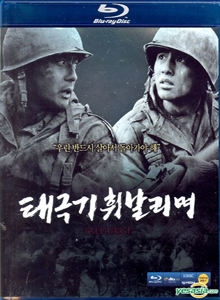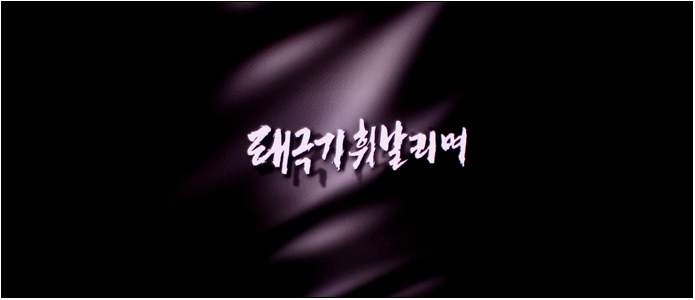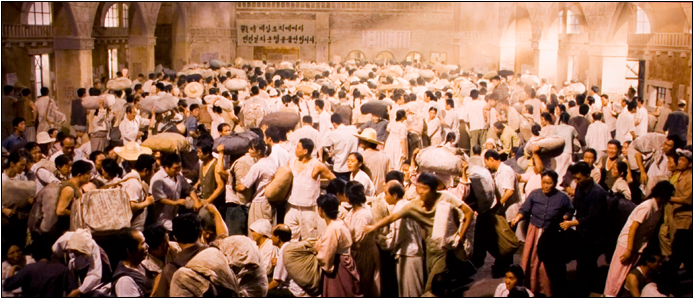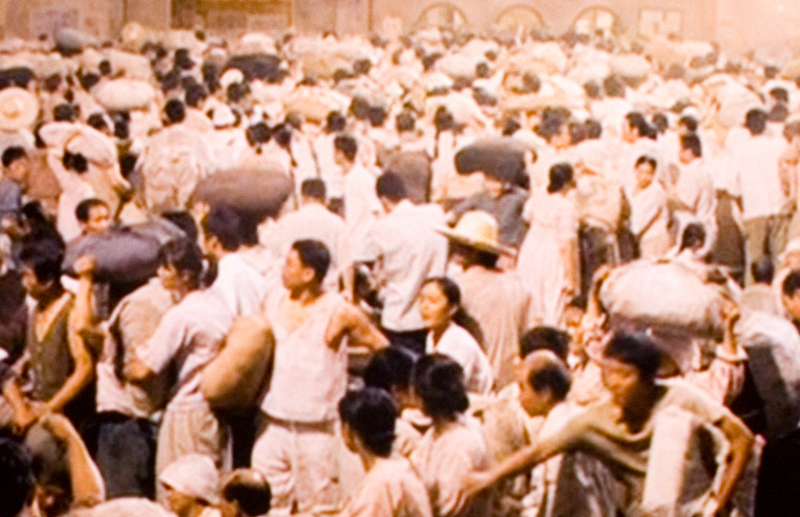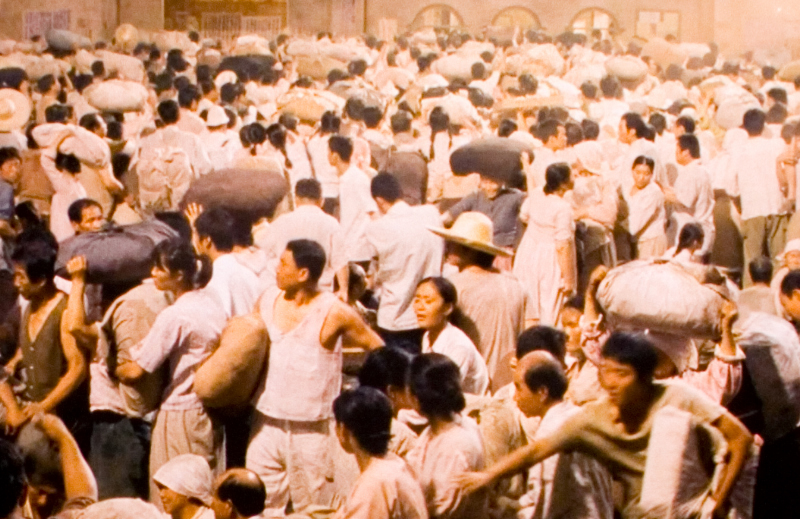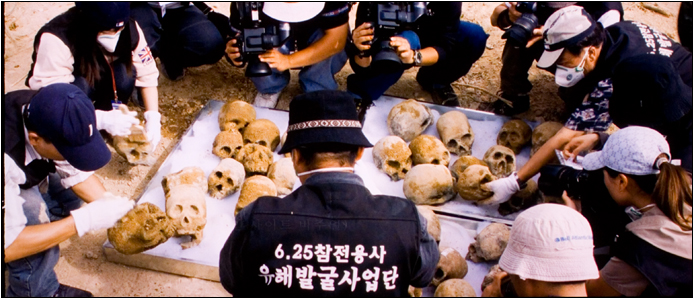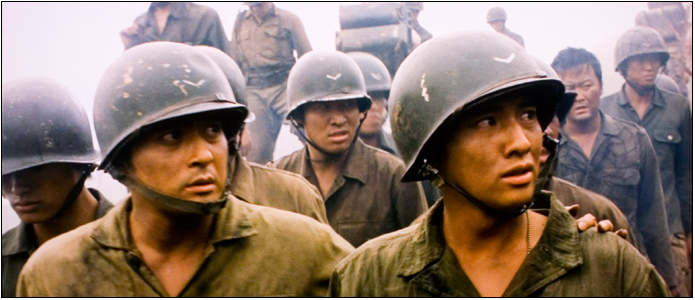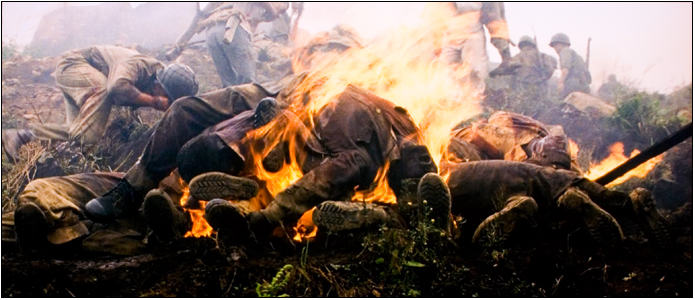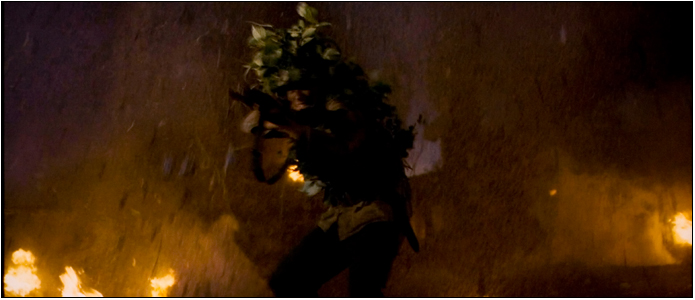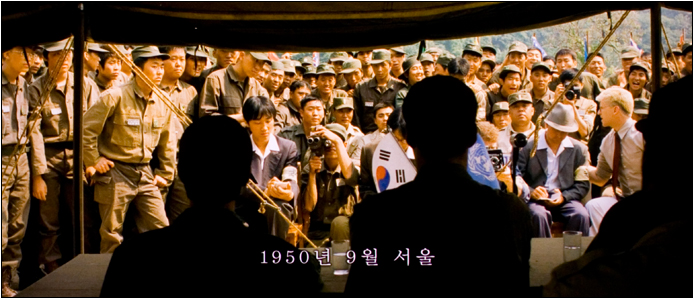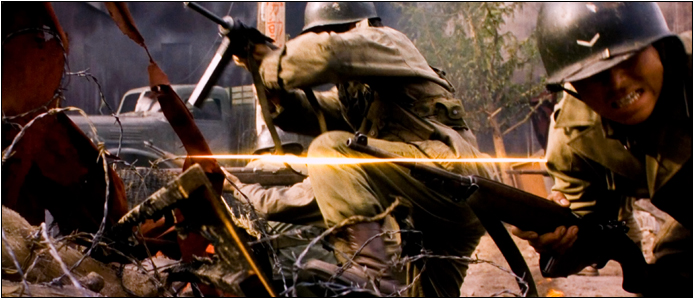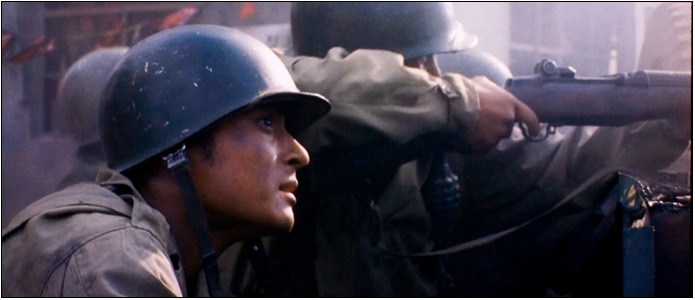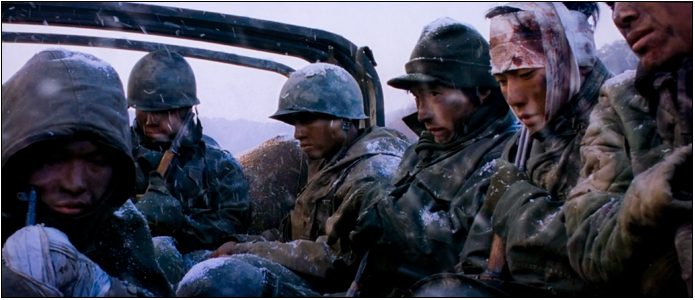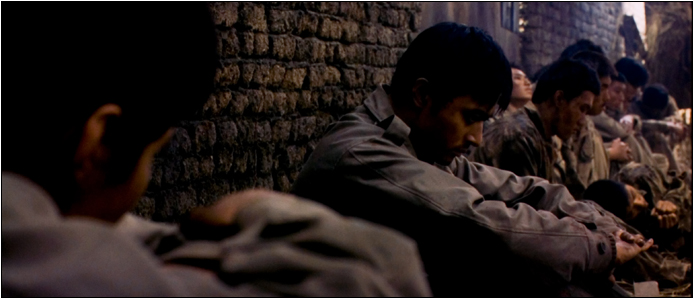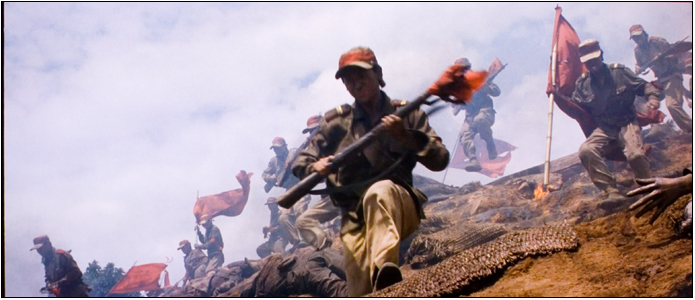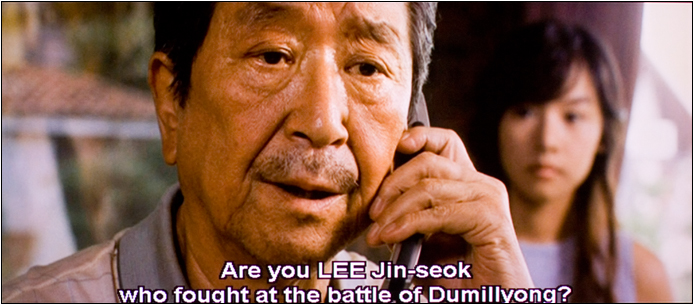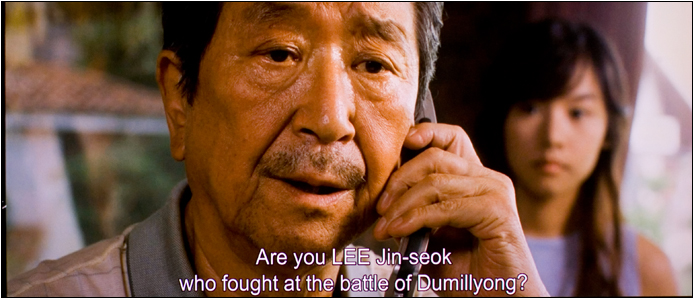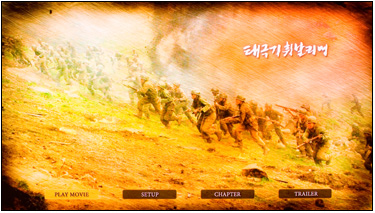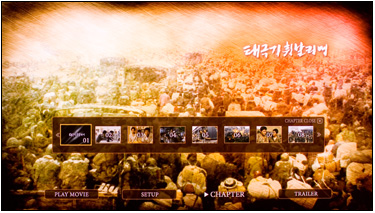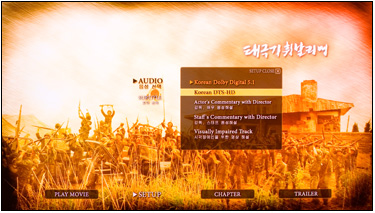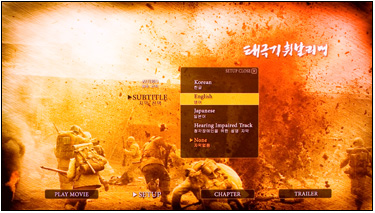|
Taegukgi
[Blu-ray]
(aka "Tae Guk Gi" or "Taegukgi: The Brotherhood of War " or
"Taegukgi hwinalrimyeo")
(Kang Je-Gyu, 2004)
Review by Leonard Norwitz
Studio:
Theatrical: Showbox & Kangjegyufilms
Blu-ray: KD Media (disc made in Japan)
Disc:
Region: A
Runtime: 148 min
Chapters: 24
Size: 50 GB
Case: Standard Blu-ray case
Release date: June 20, 2008
Video:
Aspect ratio: 2.35:1
Resolution: 1080i
Video codec: AVC
Audio:
Korean 5.1 DTS HD, Korean 5.1 DD
Subtitles:
Korean, English, Japanese, none
Extras:
• Actor's Commentary with the Director
• Staff's Commentary with the Director
• Theatrical Trailer
The Film:
Two major Korean films,
The Host and
Oldboy,
have already been released on Blu-ray by Magnolia and
Tartan Asia Extreme but, unless I am mistaken,
Taegukgi and
Welcome to Dongmakgol mark the
first purely Asian efforts at Blu-ray for a Korean film.
I took a look at them this week and compared them to
their excellent 480i Region 3 incarnations. But before
getting into the details, I want to warmly recommend
both titles from KD Media, even if their transitions in
every respect were not all that we might have hoped for,
or expected. Both Taegukgi and
Welcome to Dongmakgol
take place during the Korean War and
examine the effects of that war from the points of view
of both sides of the conflict as well as the
non-combatants. However, the tone of these films
couldn't be much different from one another. Taegukgi
is relentlessly gritty and gets grimmer as it proceeds.
Despite its alternate title, The Brotherhood of War,
Taegukgi should not be considered as a paean to the
glory of war, or to the comraderie that is often
depicted as emerging from it. Far from it. Welcome to
Dongmakgol is a modern fairy tale and, in its way,
still a powerful antiwar film.
Here's Kenneth Turan on the film: taken from his review
in the L.A. Times, Sept. 3, 2004:
"If Americans think of the Korean War at all, it's often
as a kind of half-forgotten placeholder between World
War II and Vietnam, two armed struggles with much more
active and vocal constituencies. In Korea itself,
obviously, the view is very different.
For there was a Korean conflict before the U.S. and the
U.N. got involved, and the war's aftereffects continue
in a country where casualties were 10 times the American
rate, a country that remains physically divided along
ideological lines. But even given that, the extent to
which Korea has embraced "Tae Guk Gi: The Brotherhood
of War" has been a surprise. It's not only the
box-office numbers that are noteworthy, with "Tae Guk
Gi" surpassing all other contenders, including
Hollywood behemoths like "Titanic," to be the No. 1 film
in that country's history. What makes it of more than
ordinary interest is also the way the film successfully
combines audience-friendly sentimentality with
absolutely grueling combat footage and an unexpected but
unmistakable hostility toward the entire notion of war.
. .
[...]
Perhaps the most interesting aspect of "Tae Guk Gi"
is the impact all this has on the brothers. Slowly,
almost imperceptibly, we see the inevitable changes
carnage makes in personality. Though older brother
Jin-Tae is sincere in his desire to win medals to get
his sibling home, we also see the blood lust rise in
him, see him getting consumed body and soul by the
butchery until killing becomes an end in itself.
Younger brother Jin-Seok goes through an equally
compelling transformation, going from idealizing his
brother to resenting his zeal for blood and glory to
coming to share it himself. War, finally, is shown to be
a kind of ultimate drug that allows people to act in
ways that can't be forgiven. With killing as an end in
itself, combatants lose sight of what they were supposed
to be taking up arms for in the first place. It's a
terrible lesson, and one that "Tae Guk Gi" teaches with
unexpected confidence." -
KT (L.A. Times)
Excerpt of review from L.A. Times located HERE
Image:
6.5/8
The first number indicates a relative level of
excellence compared to other Blu-ray DVDs on a ten-point
scale. The second number places this image along the
full range of DVDs, including SD 480i.
NOTE: This transfer is 1080i
The movie as seen in the theatre moves from naturalistic
photography, such as the opening scene where modern
"archeologists" uncover the battle sites from the war in
order to gather effects and remains and obtain a clearer
picture of who was involved and to inform the families
about their missing loved ones, to a deliberately
antiqued look in towns and villages around 1950, to the
grit of combat. It would be a mistake to think the
variations in contrast and color are mistakes that
should be corrected on video. That said, especially in
the early scenes of civilian life where much of the
color is drained away leaving an overexposed print, like
an old photograph, the transfer to Blu-ray captures the
intent of the director, even though it could hardly be
viewed a of demonstration material for your high
definition system. Battle scenes are another matter
entirely: sometimes lit by the stars or by explosions;
at times the color is monochromatic, like mud; sometimes
the image is crisp, at other times, murky with smoke.
It's a war, after all.
I have included comparative crops of full resolution
captures of the same frame from the blu-ray and 480i
that show the extent to which greater resolution allows
us to see into the picture. It's not just that we can
see more and see it more clearly, but that the
experience is less fatiguing as a result.
KD Media's 480i 3-disc SD spread the movie's 148 minutes
over two discs, maintaining a high bit rate throughout.
Others have reported some edge enhancement on the SD,
but I don't see that on the 3 disc set. As expected,
given that KD Media prepared both the SD and the BRD,
the new disc is much the same in color, but offers more
density to the too translucent, overexposed frames and
more bite to the scenes of battle. The blacks are deeper
without sacrificing detail where appropriate. Skin
texture is more palpable, though there wasn't much to
complexions in the SD to start with. In comparison to
the SD, though I believe I observe in the Blu-ray a
certain amount of noise/grain reduction that sometimes
gives a hint of waxiness to faces. And all this with bit
rates that wander all over the map from below 10
(truly!) to the mid 30's, often at the lower end.
Zoomed-in: SD TOP , Blu-ray BOTTOM
More Blu-ray captures
Audio & Music:
6/8
You would think that Taegukgi would benefit from an
uncompressed audio track and give this video a leg up
toward realism. I found it not so. The DTS HD mix comes
off curiously flat, the dialogue often lacking focus.
Except for the surrounding presence of ordinance and
city noises like passing busses and the like, the
channel mix on the SD has more punch – at least when
heard through my, admittedly, better D/A conversion. The
music score by Lee Dong Jun (Shiri) is strongly
derivative of similarly themed Western films - James
Horner's Glory came immediately to mind – effective and
heartfelt, if not particularly original.
Operations:
9
I very much like the menu backgrounds on this Blu-ray
and the easy navigation it presents to us. And we get
right to them after only a brief acknowledgement of a
few seconds to KD Media.
Subtitles: 7
Despite that the subtitles are clearer and crisper on
the Blu-ray, as they always are, they appear in the
frame, rather than under it. Not my preference, at all.
At least they are smaller and less obtrusive than on KD
Media's own SD. Checking several scenes for both the BRD
and the SD, the translations appear to be identical. I
never took issue with the SD in this regard, so ditto
for the Blu-ray.
SD TOP , Blu-ray BOTTOM
Extras:
3
The big disappointment is that there are no Special
Features with English subtitles. There are two audio
commentaries, but, alas, no subs. I suspect there may an
English-friendly edition in high definition someday –
after all, Taegukgi is an important movie. But, for now
– bupkis, for us non Korean-speakers. There were extras
on KD Media's stunning 3-disc DVD box set – which, by no
small way, makes me wonder once again if we will ever
see the kind of box presentations that SD DVD offers on
occasion, and which the Koreans have been particularly
good at – which were, of course, all in Korean without
subtitles as well. However, if you want to see them in
English, you can always rent the bonus feature disc of
the Columbia Tristar release of the movie.
Bottom line:
8
I haven't much to add to Mr. Turan's review and
perspective on the film, war and Korea's history. I did,
however, find that the reliance on hand-held camera work
to have something of mixed results for me. While this
faux-combat documentary technique certainly coveys a
sense of confusion and anarchy, it also feels like the
sort effect used for its own sake, much as
cinematographers did with the zoom lens in the early
1970s, like a newfound toy. This, and the impression of
dropped frames to speed up action on occasion, were
effects that, for me, marred an otherwise compelling
experience.
Taegukgi is a dynamite, moving experience, not to be
missed. Despite its mediocre audio track and the absence
of bonus features on this Blu-ray, if you don't already
own this movie on DVD, you owe it to yourself to see it.
The upgrade is really better than I make it out to be,
and it is likely that your experience of the audio will
not be as questionable as mine for the reasons stated
above. Warmly recommended.
Leonard Norwitz
July 20th, 2008
|
![]()
![]()

![]()
![]()
![]()
![]()
![]()
![]()
